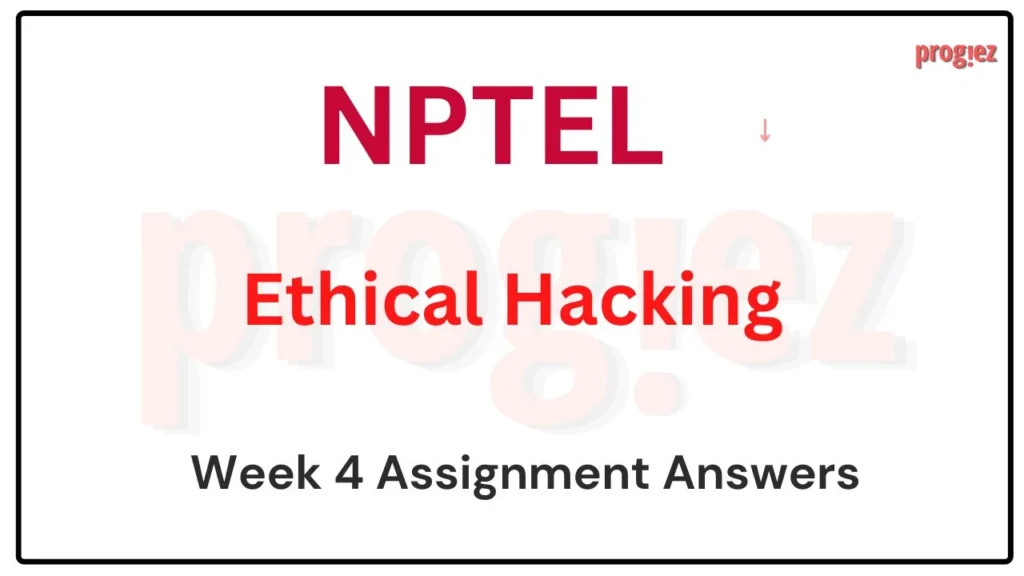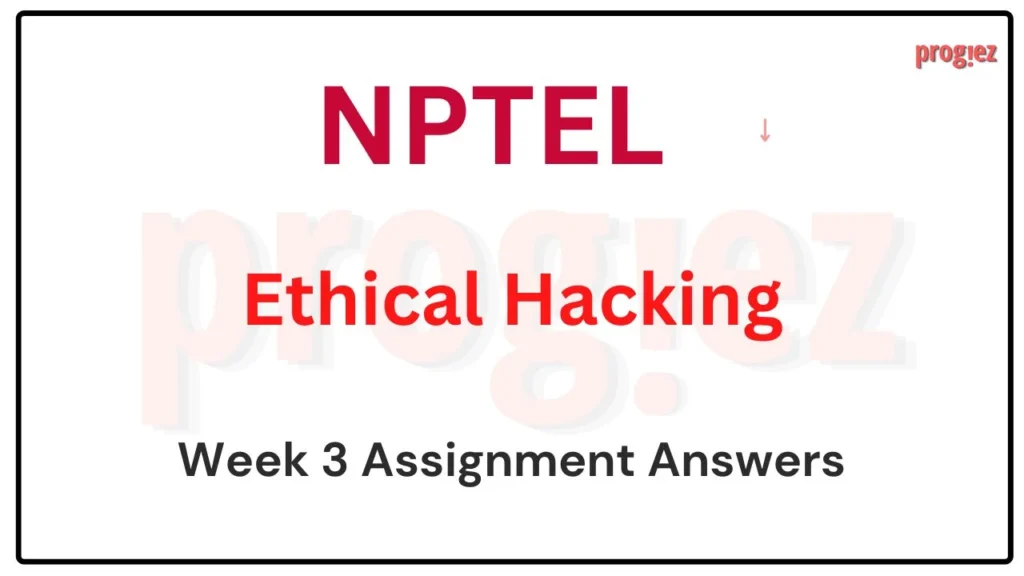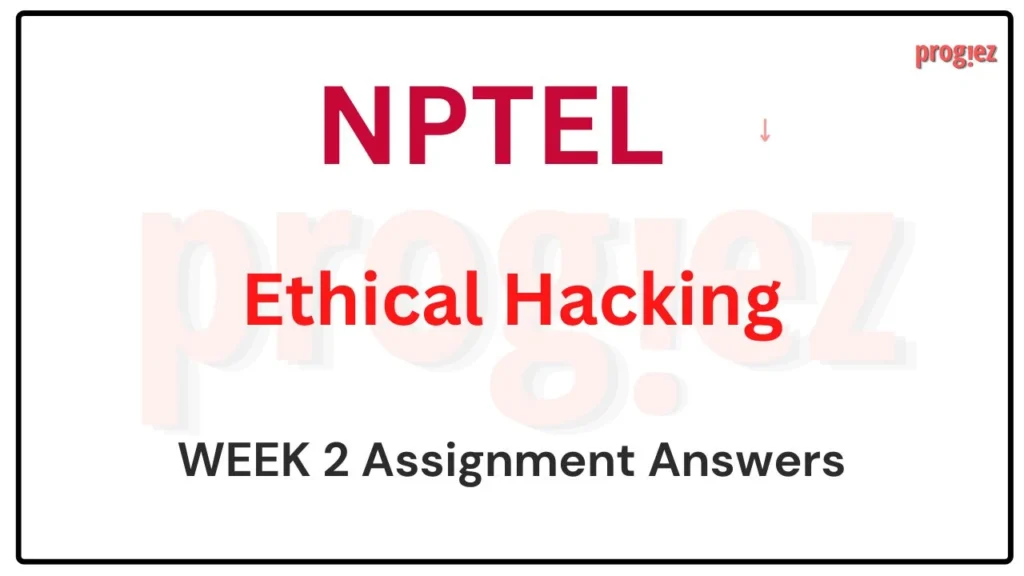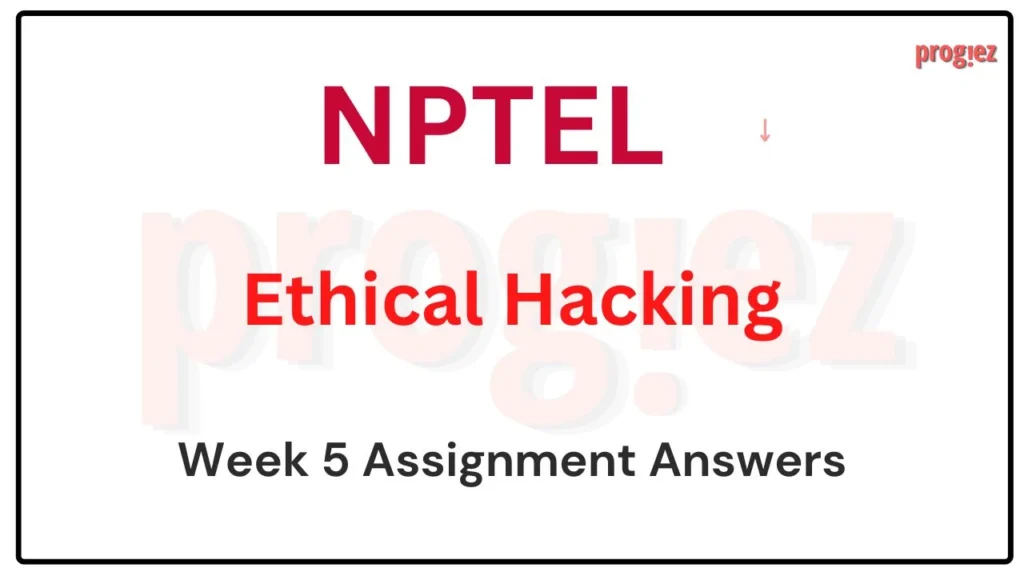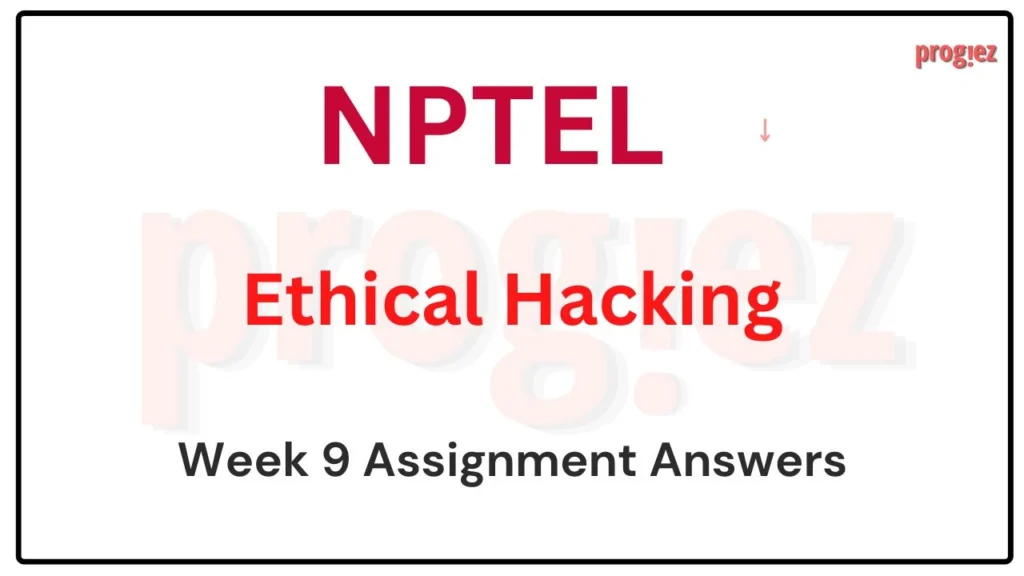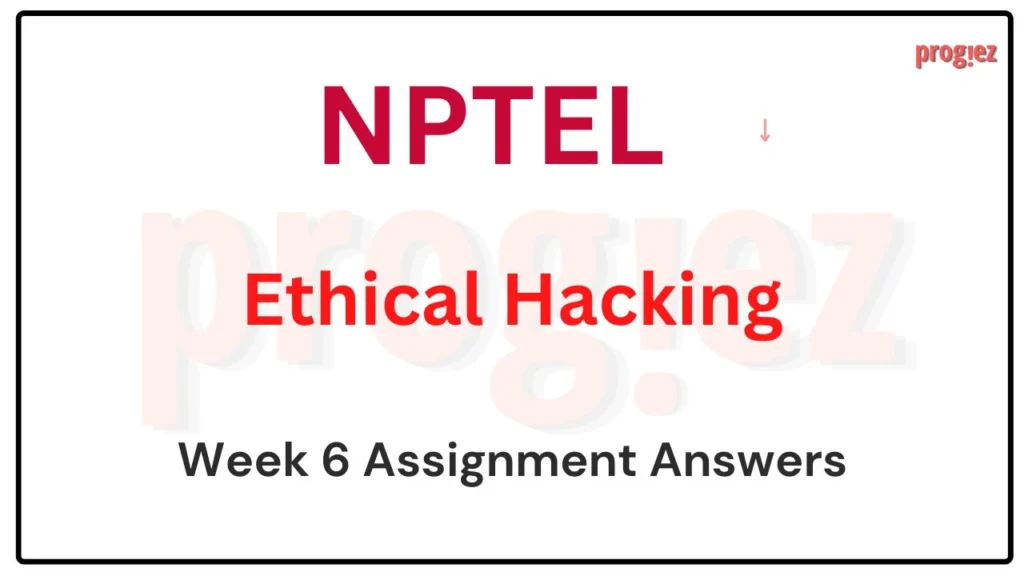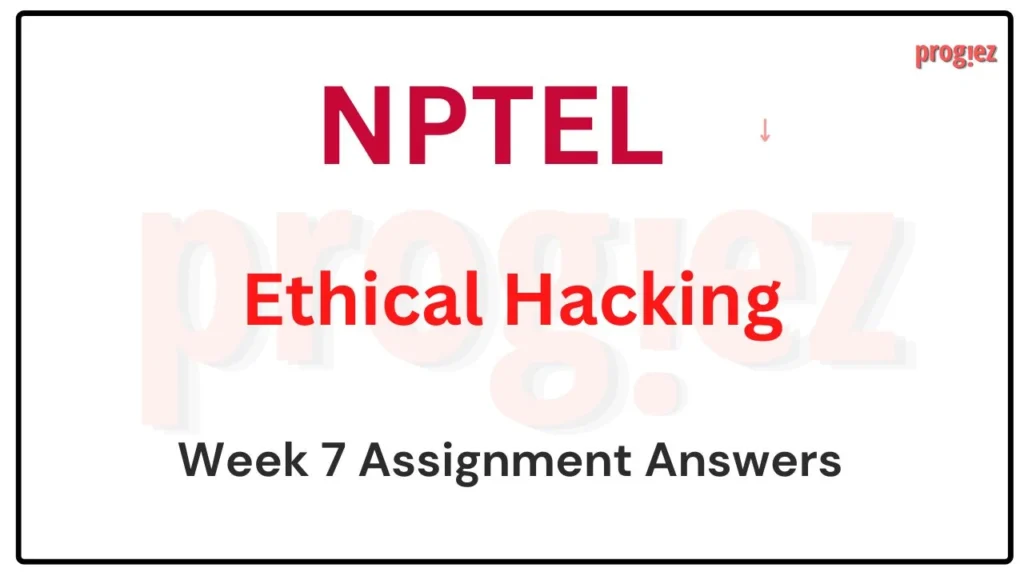Ethical Hacking Nptel Week 8 Assignment Answers
Are you looking for Ethical Hacking Nptel Week 8 Assignment Answers? You’ve come to the right place! Access the latest and most accurate solutions for your Week 8 assignment in the Ethical Hacking course.
Course Link: Click Here
Table of Contents
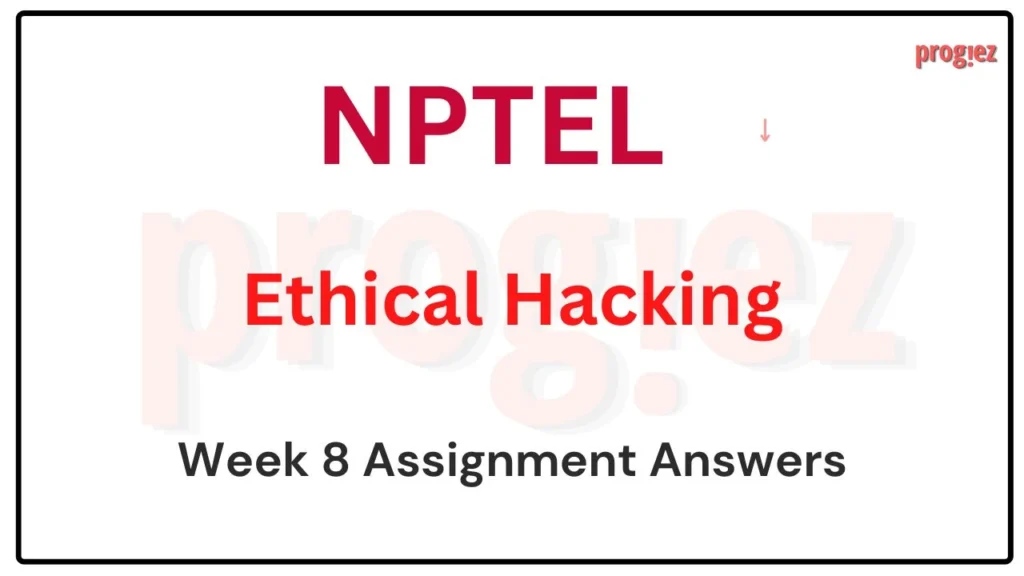
Ethical Hacking Nptel Week 8 Assignment Answers (July-Dec 2024)
- Which of the following is/are examples of steganography?
- a) Hiding some text information within an image file.
- b) Hiding some text information within an audio clip.
- c) Hiding some secret information within an executable file.
- d) Encrypting an image file so that only the intended recipient can view it.
Answer: a, b, c
- Consider a gray-level image of size 100 x 100, where each pixel is stored in 8-bits (representing a gray scale). The number of bytes of information can be hidden in the image by using LSB steganography technique is _
Answer: 1000
- Which of the following correspond to behavioral biometrics?
- a) Biometrics that relate to human behavior.
- b) Biometrics that relate to human body.
- c) Biometrics that rely on the use of a powerful computer system.
- d) None of these.
Answer: a
- Which of the following is/are example(s) of physiological feature?
- a) Retina
- b) Fingerprint
- c) Signature
- d) Typing speed
- e) None of these
Answer: a, b
- Which of the following attacks refer to the situation where an attacker gains entry into the victim machine (or spoofs the IP address) and then sends a ping request to a broadcast address?
- a) SYN flooding attack.
- b) Smurf denial-of-service attack.
- c) DNS spoofing attack.
- d) None of these.
Answer: b
- Which of the following is not an example of denial-of-service attacks?
- a) SYN flooding attack.
- b) Smurf attack.
- c) Ping-of-death.
- d) None of these.
Answer: d
- Which of the following is true for iterative name resolution?
- a) A host may have to send multiple DNS requests to several DNS servers.
- b) A host sends a single DNS request to its next higher-level DNS server.
- c) Name resolution happens recursively within the host itself.
- d) None of these.
Answer: b
- Which of the following statement(s) is/are false for HTTP Flood attack?
- a) It is exclusively a type of Distributed-Denial-of-Service (DDoS) attack.
- b) It overwhelms a target server using oversized ping packets.
- c) It overwhelms a target server with HTTP request.
- d) None of these.
Answer: a, b
- What is the full form of PGP?
- a) Packet Group Protocol
- b) Port Group Protocol
- c) Pretty Good Privacy
- d) None of these.
Answer: c
- Which of the following services are provided by PGP?
- a) It provides authentication.
- b) It provides confidentiality.
- c) It ensures availability.
- d) None of these.
Answer: a, b
For answers or latest updates join our telegram channel: Click here to join
More Weeks of Ethical Hacking: Click here
For answers to additional Nptel courses, please refer to this link: NPTEL Assignment
Ethical Hacking Nptel Week 8 Assignment Answers (July-Dec 2023)
Course Link: Click Here
These are NPTEL Ethical Hacking Assignment 8 Answers
Q1. Which of the following are examples of steganography?
a. Hiding some text information within an image file.
b. Hiding some text information within an audio clip.
c. Hiding some secret information within an executable file.
d. Encrypting an image file so that only the intended recipient can view it.
Answer: a, b, c
Q2. Which of the following statements correctly represents the term steganography?
a. Encrypting some information such that it will not be legible to an unauthorized person.
b. A low-cost alternative to encryption and decryption.
c. Secure way of communicating without sharing any key.
d. None of these.
Answer: d. None of these.
These are NPTEL Ethical Hacking Assignment 8 Answers
Q3. Which of the following correspond to behavioral biometrics?
a. Biometrics that relate to human behavior.
b. Biometrics that relate to human body.
c. Biometrics that rely on the use of a powerful computer system.
d. None of these
Answer: a. Biometrics that relate to human behavior.
Q4. Consider a gray-level image of size 1000 x 1000, where each pixel is stored in 8-bits (representing a gray scale). How many bits of information can be hidden in the image by using LSB steganography technique? Assume 1K = 1000, and 1M = 1,000,000.
a. 100 Kbits
b. 500 Kbits
c. 1Mbits
d. None of these.
Answer: c. 1Mbits
These are NPTEL Ethical Hacking Assignment 8 Answers
Q5. What is denial-of-service attack?
a. An attack on a system whereby stored files get modified or deleted.
b. An attack that destroys users information from a system.
c. An attack that destroys the stored password information in a system.
d. None of these.
Answer: d. None of these.
Q6. Which of the following attacks refer to the situation where an attacker gains entry into the victim machine (or spoofs the IP address) and then sends a ping request to a broadcast address?
a. SYN flooding attack.
b. Smurf denial-of-service attack.
c. DNS spoofing attack.
d. None of these.
Answer: b. Smurf denial-of-service attack.
These are NPTEL Ethical Hacking Assignment 8 Answers
Q7. Which of the following attacks rely on some vulnerability in the TCP connection establishment phase?
a. SYN flooding attack.
b. DNS spoofing attack.
c. Smurf DoS attack.
d. None of these.
Answer: a. SYN flooding attack.
Q8. Which of the following is/are true for Botnet?
a. ABotnet refers to a host connected to the Internet that is under control of the attacker.
b. A Botnet host runs a number of bots that are repetitive code segments with some malicious intent.
c. Itrelies on IP spoofing to mount attacks.
d. All of these.
Answer: a, b
These are NPTEL Ethical Hacking Assignment 8 Answers
Q9. Which of the following is true for iterative name resolution?
a. A host may have to send multiple DNS requests to several DNS servers.
b. A host sends a single DNS request to its next higher-level DNS server.
c. Name resolution happens iteratively within the host itself without sending any DNS request messages.
d. None of these.
Answer: a. A host may have to send multiple DNS requests to several DNS servers.
Q10. What is the full form of PGP?
a. Packet Group Protocol
b. Port Group Protocol
c. Pretty Good Privacy
d. All of these.
Answer: c. Pretty Good Privacy
These are NPTEL Ethical Hacking Assignment 8 Answers
